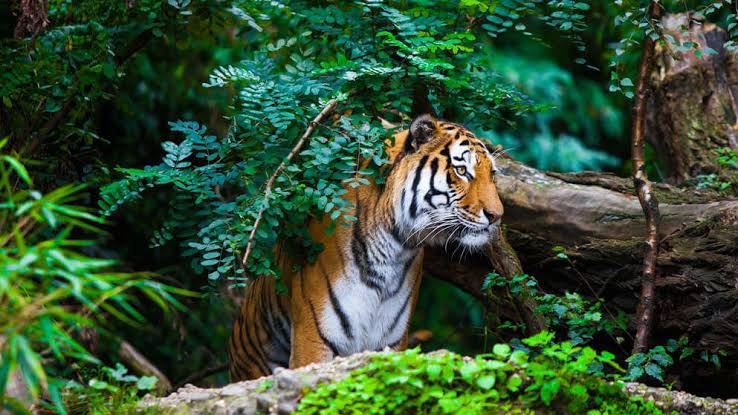Revival of the tiger: A joint effort, a cultural renaissance (Indian Express)

- 06 Jan 2024
Why is it in the News?
Jim Corbett Tiger Reserve has achieved success through comprehensive conservation strategies, including habitat protection, community involvement, and ecological sustainability. The reserve's efforts focus on maintaining a balance between wildlife conservation and the well-being of local communities, showcasing a commitment to the coexistence of both nature and people.
Background:
- India has a profound history of forest and wildlife conservation, marked by a notable achievement at the Corbett Tiger Reserve (CTR) in Uttarakhand.
- CTR has seen the successful implementation of comprehensive efforts and strategies, resulting not only in a remarkable rise in the tiger population but also establishing itself as a global exemplar in wildlife management.
About Jim Corbett National Park:
- Established in 1936 as Hailey National Park, Jim Corbett National Park holds the distinction of being India's first national park.
- In 1973, it gained Tiger Reserve status, becoming the pioneer in the Project Tiger initiative.
- Nestled in the Shivalik hills of the Himalayas, Corbett Tiger Reserve spans across the Pauri Garhwal, Nainital, and Almora districts of Uttarakhand.
- Renowned for its global record, it proudly hosts the highest tiger density, reaching 260 in 2022, a notable increase from 231 four years earlier.
Cultural and Economic Significance of Tigers in India:
- Beyond ecological importance, the tiger carries profound cultural and historical significance in India.
- The resurgence of tiger populations, particularly at CTR, represents a cultural revival and the renewed embrace of conservation values.
- The thriving eco-tourism industry illustrates the economic interdependence between local communities and tigers, highlighting the profound connection between wildlife and people at CTR.
An Overview of Effective Biodiversity and Tiger Conservation Plan at CTR:
- Implementation of a Comprehensive Strategy: CTR owes its success to the meticulous execution of the Tiger Conservation Plan, focusing on the well-being of both tiger populations and broader biodiversity.
- Spanning 1288.31 sq km across Uttarakhand, CTR showcases the plan's efficacy in nurturing a flourishing ecosystem.
- Clear Division of Core and Buffer Zones: The foundation of the Tiger Conservation Plan lies in delineating core and buffer zones within the reserve, offering wildlife a sanctuary.
- Core zones provide undisturbed habitats crucial for breeding, while buffer zones minimize conflicts between human settlements and wildlife.
- Increase in Tiger Population: Recent statistics highlight a significant rise in CTR's tiger population, from 231 to 260 in just four years.
- This surge underscores the plan's success, safeguarding not only tigers but also the overall health and balance of the forest ecosystem.
- Maintenance of Rich Biodiversity: CTR's success extends beyond tiger numbers, encompassing a biodiverse landscape that attracts researchers, conservationists, and tourists.
- The diverse flora and fauna contribute to ecological balance, fostering harmonious coexistence between predator and prey.
- Promotion of Ecotourism and Conservation: CTR's vibrant ecosystem has made it a hub for ecotourism, creating economic opportunities for local communities.
- Tourists contribute to both nature appreciation and the local economy, making conservation and tourism mutually beneficial.
- Effective Grassland and Water Management: CTR employs a nuanced approach to grassland management with 27 grassland types, crucial for sustaining prey species.
- Strategic water management, including solar-pump-fed waterholes, supports diverse wildlife needs, ensuring a sustainable ecosystem.
- Dedicated Forest Staff: The dedicated forest staff, comprising foot-soldiers, mahouts, and guards, are integral to CTR's success.
- Initiatives like timely wages and enhanced safety measures underscore the importance placed on the well-being of these unsung heroes.
- Focus on Wildlife Corridors and Habitat Protection: CTR prioritizes wildlife corridors for gene pool exchange, aligning with the Tiger Conservation Plan's recommendations.
Human-Wildlife Conflict at CTR:
- Increasing Incidents and Challenges: The upsurge in conflicts between humans, elephants, and tigers at CTR stems from factors like habitat encroachment, limited animal corridors, and the behavioral conditioning of predators.
- Straying milch and domestic animals from villages become easy prey for tigers, leading to predatory behavior towards humans, especially in buffer forest areas.
- The Complexity of 'Wicked Problems': Described as a 'wicked problem' due to its intricate nature, human-wildlife conflict at CTR requires a nuanced and context-specific approach.
- CTR emphasizes the significance of every solution attempt, recognizing that there's no one-size-fits-all remedy, and continuous adaptation and innovation are essential for evolving conflict scenarios.
Strategies Implemented for Human-Wildlife Conflict Mitigation and Co-Existence Promotion at CTR:
- Forest Department Initiatives: Proactive measures by the forest department at CTR have successfully eliminated poaching activities, particularly along the sensitive southern boundary.
- Dedicated foot soldiers, along with digital surveillance through the electronic-eye project, have played a pivotal role in reducing wildlife threats.
- Community Engagement Strategies: Community engagement is fundamental to CTR's approach to resolving human-wildlife conflicts.
- Local stakeholders actively participate in conservation through initiatives like the Living with Tigers program, engaging villagers and school children in behavioral and response awareness.
- This educational effort aims to deepen understanding of wildlife behavior patterns and promote practices that enhance safety for both humans and animals.
- Provision of Economic Incentives for Conservation: The forest department has initiated projects offering economic incentives for conservation, such as the beehive-fencing project.
- Strategically placing beehives along village-forest borders, the resulting Corbee Honey brand is managed by local Eco Development Committees (EDCs), fostering economic cooperation and coexistence with local stakeholders.
Conclusion
- Corbett Tiger Reserve emerges as a triumph in wildlife conservation, embodying a comprehensive and integrated approach. Through careful habitat management and community engagement, CTR exemplifies the promise of sustainable coexistence between humans and wildlife. As an integral chapter in India's conservation story, the ongoing success of the reserve relies on the collaborative endeavors of the forest department, local communities, and passionate conservation advocates.
